Alchemy Horizon: Baldur’s Gate Limited

Last week I discussed Double Masters Booster draft. Today I want to go over Baldur’s Gate Limited. This is an MTG Arena-only format that will be the format for a few qualifier events and a Limited Arena open. The format has received a lot of hate, but I think it’s actually pretty fun.
Specialize has been the subject of discussion regarding the cards’ wordiness. This is valid criticism, but the specialize cards have similar abilities on all colors, so it’s something you get used to eventually. Every single specialize creature ranges from solid to the best card in the set (Lae’zel, Githyanki Warrior). When I first started drafting, I took the specialize creatures before I read them and it was usually correct.

Double Team is another new ability from this set, and every card with this keyword is good. The only exceptions are Lizardfolk Librarian, which is a totally fine card but in the worst color, and Ranger Squadron, which is playable and even good, but you don’t want to load up your deck with six-drops so you try and get it late.
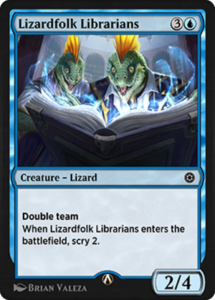

The set can be quite aggressive, but in reality, the pace of the game will be dictated by how each player develops in the early turns. If you’re able to stop the early Double Team creatures and make it awkward for your opponent to get profitable attacks in, you can easily slow the pace of the game down to a crawl.
I like cards like two-mana 1/3s with upside to do this, and my favorite common in the set is easily Genasi Rabble-Rouser. Genasi Rabble-Rouser can play offense and defense well, and it’s easy to trigger its Double Team, as it’s hard to block effectively in the early turns.

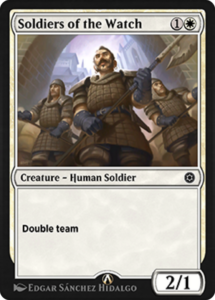
RW is my pick for best archetype in the format because of two key commons—Soldiers of the Watch and Genasi Rabble-Rouser. Both of these cards ensure you have multiple early plays if you’re able to get a profitable first attack. You don’t need to be overly aggressive with RW because you have a flow of cards from Double Team creatures that you can play a one-for-one game if you’re able to get the ball rolling early.
Typical RW decks:
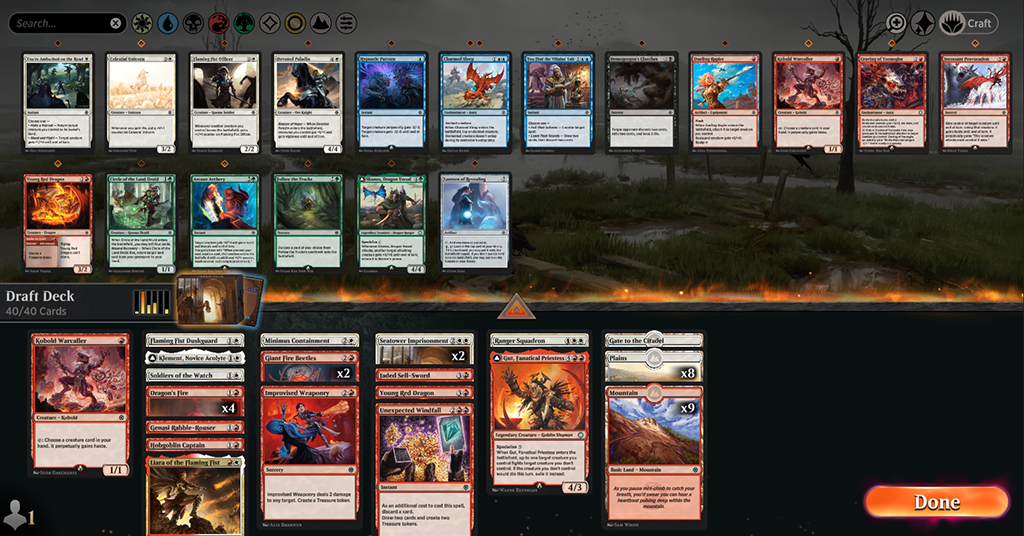
Both of these decks have cards up and down the curve and aren’t that reliant on getting ahead early. While these aren’t the ideal RW Decks, they play out just fine.

Red is my favorite color but not by a whole lot. I like black and white almost as much, and they’re all pretty close with regards to power level. Both Gensai Rabble-Rouser and Dragon’s Fire are two of the top commons in the format and cards I like to use to bridge into a late game.

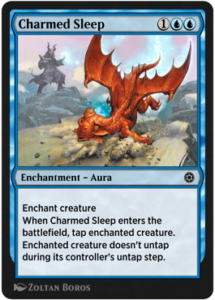
Blue has a reputation for being pretty bad, and I spent a good amount of time trying to make blue decks work. They weren’t unplayable, but the commons in blue are incredibly weak. Charmed Sleep is the only real blue removal, and it has huge problems in a format where it’s important to sacrifice things for value, blink, or return things.
Blue lacks a really strong first-pickable common, and the only reason I generally go into blue is because I picked up a rare that pushes me in that direction. Ideally, blue ends up being a support color in an otherwise good deck.
Here are some blue decks:

Snowborn Simulacra is powerful and a card I’m happy to pick first. With random treasures laying around and ramp out of green, it’s easy to get to at least seven mana.

This is the coolest deck I’ve drafted in the format thus far, and it’s loaded with rares I got late. I wanted to try Signature Spells out, and it didn’t disappoint in this deck, but in general there’s not enough three-drop spells to first-pick-it-pack-one, and there are tons of incidental ways to interact with the enchantment.
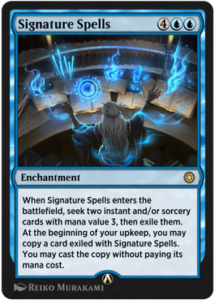
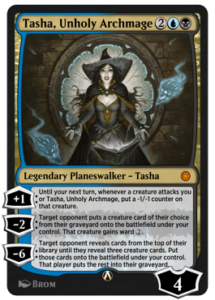
Tasha, Unholy Archmage is messed up and has hard-carried a couple of my bad blue decks, including this Signature Spells deck and this UB Control deck.
I played a bunch of counters and stuff that could block. I managed six wins with this deck, but I couldn’t imagine having a chance without the planeswalker.
Green is a color that is often open and sneakily good. In fact, BG is my preferred archetype right now, either with a self-mill or value plan. I prefer BG because red and white have felt overdrafted recently as people are adjusting to the format, and if I want, I can almost always pick up green.
BG were the last two decks I drafted and both were trophies with one total loss between them:

This deck was more in the self-mill category. It played out much better than I anticipated because I was often able to pull ahead in the midgame by just slamming big creature after big creature while trading off early.

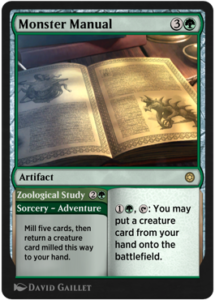
Earthquake Dragon makes a rare appearance, as I had enough self-mill and a Monster Manual to put in play. I was also able to cast it multiple times with reduced cost from a seven-mana dragon in play.

Dread Linnorm is a card I’m usually able to pick up late and has been my MVP in all my green decks. Having a combat trick that also untaps your creature makes it hard to play around. Generally, I find if I’m able to leverage the adventure half, Scale Deflection, it will put me far enough ahead, or at least in a comfortable spot, that I can close the game with the Dread Linnorm. It’s an adventure card where both halves do so much work.

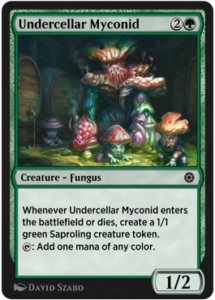
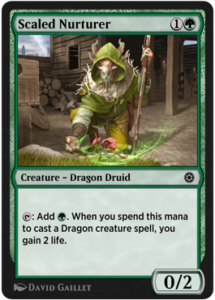
Between Dread Linnorm, Owlbear, Undercellar Myconid, and Scaled Nurturer, green has a few solid commons that often go late enough that I’m happy to be in green. Band Together is the common green removal we have, and while it’s not great, it’s good enough to get the job done, and it’s a card you’re usually able to pick up late in packs and even occasionally wheel.
Here’s a more traditional good-stuff BG deck with multiple splashes:

Between Pilgrim’s Eye, Prophetic Prism, Treasures, and various other fixing, splashes are super easy in this format. In fact, Pilgrim’s Eye was a card I underrated at first. I saw the format as fast and linear and thought the body on Pilgrim’s Eye was too much of a liability. I was mistaken because I realized that Shambling Ghoul would also be a great early play in nearly any deck as it helped me keep my life total high against a lot of one-toughness creatures and eventually would trade off for something. Pilgrim’s Eye enables splashing bombs, which this format in many regards is all about once you get through the early stages of the game.
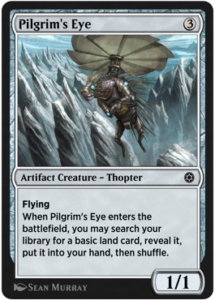

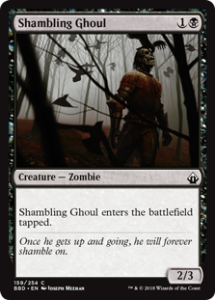
This deck was just loaded with two-for-ones, and I was able to bury most of my opponents in card advantage. I considered playing red over green but didn’t have enough early plays, which is something you need in this format. It’s tough to recover if you don’t spend mana on turn two when you’re on the draw. Double Team creatures usually end up snowballing on you.
Because of Specialize, Double Team and the Gates, I often like to play 18 lands in this format. Even in Bo1 I up my land count since missing land drops is an easy way to lose in this format, as there’s just so many two-for-ones that your opponents will often use tons of mana. It’s hard to play a one-for-one game with only a couple of lands. Since specialize works with land, it’s always fine to have an extra land laying around.
Specialize is another reason that splashing is less punishing. Sometimes you don’t have the mana for a splash card, or you do, but your opponent doesn’t see that red splash to deal them some extra damage and they don’t expect that out of your BG deck. Having more options with specialize is another solid upside for splashing.
I was a bit lower on the Gates initially because I was picking up tons of Double Team creatures throughout my drafts. Often wheeling the two-drop Double Team creatures, I was never running out of stuff to do with my mana, However, the Gates are truly incredible. They don’t just draw you a card, they always draw you specifically a spell, and when you’re activating it you’re probably flooding or out of spells to cast, so you have the mana. I have been taking them earlier and earlier as I learn the format and understand just how deep into my pile I’ll have to go to get enough playables.
Overall, Alchemy Horizon: Baldur’s Gate is a fun format, but the first five or so drafts are a bit overwhelming. Learning the specialize cards is obnoxious initially, but once you get used to it, the format ends up being quite fun. My short, best advice is always play one more land than you think necessary but also try to keep your curve lean.
Image Copyright: (c) 1995-2020 Wizards of the Coast LLC, All Rights Reserved





